「となりのトトロ」 (My Neighbour Totoro) is a very popular children's anime film from Studio Ghibli (Japan's premier animation film studio). It is written and directed by 宮崎駿さま (MIYAZAKI Hayao). Originally released in 16 April 1988 as part of a double feature alongside 「火垂る の墓」 (Grave of the Fireflies), it continues to watched by many Japanese children today, and many young Japanese adults will have watched the film at least once in their lives.
Some Japanese have told me that 「となりのトトロ」 affects them deeply, and make them feel nostalgic. Certainly the film conjures up an image of rural Japan post World War II, before Tokyo became an urban concrete sprawl, when it was still possible to encounter small villages, farmland, and forests within the reach of the public transportation system. Also, the film espouses many traditional Japanese values and beliefs.
For my part, 「となりのトトロ」 is one of my favourite Japanese films, and quite possibly the favourite. Therefore, when I started learning Japanese, one of my goals was to be able to appreciate this film fully in 日本語 (the Japanese language) rather than through subtitles and English dubs, and to understand the cultural context of the film. This article summarises some of my thoughts and notes on the film itself, from the perpective of my Japanese studies.
Accordingly, the translations of Japanese text provided in this article are done by myself. I apologise in advance for any translation errors caused by my limited understanding of Japanese. I also apologise for any contextual misinterpretations due to my lack of understanding of Japanese culture.
The characters
According to a 絵本 (picture book) that I bought, the major characters are:
- 草壁メイ 4さい げんきで、こうきしんの つよい いもうと。 (KUSAKABE Mei, 4 years old, energetic and strongly inquisitive little sister)
- 草壁サツキ 小がっこう 4年 あかるく、しっかりものの おねえさん。 (KUSAKABE Satsuki, Grade 4 primary school student, bright and steady big sister)
- おとおさん 草壁タツオ がくしゃ、大がくの せんせいも して いる。 (Father, KUSAKABE Tatsuo, an academic who also teaches at university)
- おかあさん 草壁ヤスコ びょうきで、1年まえから にゅういんして いる。 (Mother, KUSAKABE Yasuko, who is ill and has entered hospital a year ago)
- 大垣カンタ サツキの どうきゅうせい。 (OOGAKI Kanta, Satsuki's classmate)
- カンタの おばあさん。 (Kanta's grandmother)
In addition, the film features 「トトロ」 (Totoro), which are living things from ancient Japan. They dwell in the forest eating nuts and are generally invisible. They tend to sleep in the daytime, but in the full moon like to blow on ocarina (a type of Japanese flute or pipe). There are three Totoros in the film:
- 大トトロ (Big Totoro, about 1,300 years old and 2 metres tall)
- 中トトロ (Medium Totoro, about 600 years old)
- 小トトロ (Small Totoro, about 100 years old)
Incidentally, there seems to be a common misconception on the Internet that the word トトロ is メイ's mispronunciation of the word 「トロル」 (troll), but if one examines the actual dialogue spoken in the movie, this is not quite the case. メイ interprets the トトロ's yawns as "to-to-ro" and imagines that it must the creature telling her it's name:
トトロ:トオー、トオー、ブロロローー ("TOO, TOO, BURORORO ...")
メイ:トトロ!あなた、トトロって いうのね。 ("Totoro! You are called Totoro, aren't you?")
Later on, when サツキ wakes メイ up, the following conversation happens:
メイ:トトロ いたんだよ ("I'm telling you Totoro was here!")
サツキ:「トトロ」って えほんに でてた 「トロル」の こと?("When you say Totoro, is it the troll from the picture book? [The Three Billy Goats Gruff, translated from the Norwegian De tre bukkene Bruse, the mother is shown reading this picture book to サツキ and メイ during the end titles]")
メイ:うん。トトロって ちゃんと いったもん。けがわえて こんなくちしてて、こんなのと、こんくらいのと、こんなに おおきいのがねてだ ("Yes. [But] it said 'Totoro' exactly [the emphasis is mine, but 「ちゃんと」 was used in the dialogue]. It had fur, and a mouth like this, and there was one this big, one approximately this big, and a large one that was sleeping.")
サツキ seems to accept メイ's explanation, because when the father arrived, she said: 「おとうさん、メイ、ここで トトロに あったんだって」 ("Father, Mei said that she met Totoro here.") Clearly, if Satsuki had continued to believe メイ was mispronouncing the word "troll", she would not have used the word トトロ when speaking to the Father.
Totoros ride a big ネコバス (Catbus) with 12 legs. The film also features tiny little black dust motes called ススワタリ (Susuwatari).
The appearance of the characters
One of the reasons why I like 「となりのトトロ」 is all the characters in the film are "average" looking Japanese. Given that there is such an emphasis on youth and beauty in modern day Japan (wandering around the streets of Tokyo, it is easy to get the impression that Japan is full of young, extremely attractive looking people rather than the rapidly ageing society that it actually is) it is refreshing to see characters that look decidedly, well, plain-looking, rather than the cutesy doe-eyed doll-like girls typically drawn in anime films.
The father is definitely nerdy and non-athletic, and quite possibly look like a young 宮崎さま. The mother is no classical Japanese beauty, サツキ is rather scruffy and tomboyish, and メイ definitely does not look "cute as a button." Indeed, from several angles, she seems rather unattactive - like all toddlers, she has her cute moments, but also ugly moments. カンタ looks like a typical village boy who has spent too many hours in the sun, and おばあちゃん has a face that reflects wisdom and experience rather than grace and refinement.
The girls appear to wear the same clothes throughout most of the film, which reinforces the fact that they don't have a mother to take care of them. One can imagine that they would look somewhat untidy and unkempt to strangers. サツキ's hair appears rather unruly, and it is interesting that when she visits her mother in hospital, she wisely avoids scolding them for their appearance (since she knows fully well the reason why they look untidy) and insteads starts brushing サツキ's hair, which pleases サツキ greatly.
Speech patterns of the characters
メイ's speech is typical of many Japanese toddlers - she speaks exclusively in the plain form, and has a restricted vocabulary. She tends to repeat any unusual words that her big sister サツキ utters (eg. ドングリ) and has a cute tendency to refer to herself in the third person, with lines like 「メイもいく」 ("Mei go too!") and 「メイこわくないよ」 ("Mei is definitely not scared!"). This is because the Japanese language does not really have true personal pronouns in the same way as English so quasi-pronouns like 私 (originally "private") are often substituted when referring to oneself. Boys are taught from an early age to refer to themselves as ぼく but there is no real equivalent for girls, hence the use of the third person. Indeed, some girls carry the habit of referring to themselves in the third person even when they reach adulthood.
Occasionally, her sentences are not well constructed (perhaps because she doesn't know the right way to express opinions or preferences). For example, she exclaims 「メイ リスがいい」 (Mei [thinks] squirrels are good!) when she really means that she would much rather believe that the ドングリ were left by squirrels rather than mice.
マイ actually sounds surprised when she heard サツキ being referred to by her new friend みっちゃん as 「サツキちゃん」 that she openly commented on it: 「サツキちゃん」だって…
The only time I feel メイ's speech may be out of character is when she said 「おとうさん 先生 お話してる。」 ("Father is talking to the doctor.") which is grammatically quite complex (お話してる requires converting a verb into a noun, attaching a honorific, then reconverting it into a progressive "doing" verb).
さつき's speech is also typical of girls her age - she is far more comfortable using the plain style, but is capable of using polite speech (丁寧語) when writing a letter to her mother and talking to strangers (although, judging by her letters, she is not completely comfortable expressing herself in this manner and occasionally uses the plain rather than polite equivalent of words - such as her use of いっぱい rathern たくさん in one of her letters). She uses あたし when referring to herself, which is probably something she learnt from her mother who also uses this feminine construct as a personal pronoun.
Even without knowing any details about the father, the viewer of the film can easily guess that he is a well educated and well-mannered man. His question to カンタ 「お家の方 どなたか いらっしゃいませんか。」 ("Isn't someone from the house around?") is delivered using honorific language (the equivalent of someone uttering the Queen's English using "received pronunciation"). Given that he is addressing a boy, this would sound strange indeed, and from this an astute viewer could probably have guessed that he was either a civil servant or academic (the latter probably being more likely given he does not appear to be well-off). In other words, the villagers probably already know of his occupational status and therefore he was expected to speak like that.
When talking to the girls, the father uses a much more casual style, and his sense of humour is evident in his conversation. For example, when the girls ask him about the dust motes, his reply was 「こりゃ マックロクロスケ だな」. まっくろ means "pure black" or "truly black" and くろすけ roughly means "black thing". So, effectively, he was saying they are "black things that are truly black." サツキ's reply was 「マックロクロスケ?絵本に 出てた?」 ("Makkurokurosuke? Out of the picture book?") indicating that they are both referring to a name from a children's picture book.
Also, when メイ warned her father she thinks the house may collapse because it's so old, he laughs and replied 「引っ越したばかりで 潰れるのは 困るな。」 (Since we have moved in, we will be in trouble if the house collapses!)
カンタのおばあさん (Kanta's grandmother) is the hardest character for me to understand in the film, as she seems to use a lot of colloquialisms in her speech.
The film in relation to other Studio Ghibli movies
If one takes some degree of poetic licence, it is possible to reframe 「となりのトトロ」 as one chapter in an overall story arc that encompasses the other Studio Ghibli films set in Japan. In particular, it is possible to imagine the following films as being set in the same "location" (somewhere vaguely on the outskirts of modern day Tokyo):
- 「もののく姫」 (Princess Mononoke)
- 「火垂る の墓」 (Grave of the Fireflies)
- 「となりのトトロ」 (My Neighbour Totoro)
- 「平成狸合戦ぽんぽこ」 (Pompoko)
- 「耳をすませば」 (Whisper of the Heart)
- 「千と千尋の神隠し」 (Spirited Away)
「もののく姫」 depicts an epic saga concerning the battle between humans and animal spirits for dominion of the earth. Although it is clear that the location is probably not modern day Tokyo, one can imagine that a similar battle would have taken place near Tokyo as well a long long time ago. Therefore, トトロ can be considered a descendant of these ancient animal gods, still surviving in a forgotten forest yet untouched by human development.
In 「火垂る の墓」 the timeline has shifted to Japan at the end of World War II. Although the story is ostensibly set in 神戸 (Kobe) one can imagine similar stories happening in Tokyo. So, in a sense, サツキ can be considered the alter-ego of セツ子 (notice the similarity in pronunciation of the girls' names) in an alternate reality where she survived the horrors of the war. This would explain why she is so strong and resilient, and yet fragile and insecure as well (particularly concerning her mother's health, as she would probably have witnessed many deaths in her childhood). Another clue to the tie in between the films is that サツキ's friend みつ子ちゃん looks eerily similar to セツ子.
In 「平成狸合戦ぽんぽこ」, the "concretization" of Tokyo has reached a point where the farmland on the outskirts of Tokyo are rapidly being swallowed into huge housing development projects. Even forgotten forests such as where トトロ lives will soon be cut down and replaced by offices and residential housing. Soon we can imagine トトロ will no longer have a place to live.
By the time of 「耳をすませば」 the conversion is complete and the forests are no more. The hill has been completely replaced by houses but there is still some magic in the location affecting the characters of the story.
Finally in 「千と千尋の神隠し」, which is also set in modern day Japan, one can imagine トトロ amongst the dreary set of dispossessed and dislocated spirits who visit Zubaba's bathhouse every night, cleverly located in an abandoned theme park. Indeed, はく's river may well be the river featured in 「となりのトトロ」, but long since diverted into an underground stream.
Did the events in the film actually take place?
It is of course possible to enjoy the film by interpreting it literally. Yes, the girls did meet トトロ, and the ネコバス and スススわたり truly exist.
However, it is also possible to interpret the film as a shared fantasy. In other words, the film depicts through animation the imagination of two young girls without a mother in strange surroundings. Therefore, the film is really a window into the girls' minds, and we see things from their perpectives. This interpretation is supported by at least one footnote in the storyboards, where 宮崎さま marked a scene as 「想像の映像」 (imaginary scene).
According to this alternate interpretation, トトロ is effectively a creation of メイ's imaginative mind, possibly within a dream. The genesis of the fantasy is provided by various elements introduced the beginning of the story, such as the mysterious camphor tree, ドングリ (acorns), スススわたり etc.
This leads to a belief that the house is haunted. メイ's subconscious therefore concluded that there must be a magical being living in the nearby forest in the tree that eats ドングリ. The image for トトロ comes from a depiction of a troll in a picture book, but to make it friendly メイ believes that it has soft downy fur and therefore resembles a gigantic teddy bear.
メイ's fantasy is then transferred to サツキ whilst she is waiting for her father in a bus stop and becoming drowsy.
トトロ also acts as a father figure to メイ and サツキ, and gives them additional comfort to allay their fears over their mother's health. He has magical powers, and therefore will be able to help them in times of danger and need (just like many Japanese schoolchildren believe ドラえもん [Doraemon] will help them in their studies or when they are in trouble). The girls jointly extend the shared fantasy by pretending トトロ gave them some seeds in return for borrowing their father's umbrella (in reality they probably collected these seeds near the bus stop and near their house). They have a shared dream that the seeds grew into a forest, and トトロ takes them on a flight and they join him in blowing オカリナ (which in reality is simply the sound of the wind).
Therefore, when サツキ calls for トトロ's help in searching for メイ, in reality she climbs the giant tree in the forest, and because of that was able to see メイ in the distance. She then further imagines that the ネコバス (in reality probably her bicycle) was able to carry her to メイ, and then carry both of them to the hospital.
Where is the film set in?
The film is set in a fictional village called 松郷 (Matsugou) on fhe outskirts of a large city (presumably Tokyo). It is reachable via a private train company called Azuma Dentetsu (東電鉄, or literally "Eastern Electric Railway"). The village consist of only around half a dozen houses, and primarily is a farming village surrounded by cornfields and ricefields. From the train station, a bus route passes in front of a small Inari (fox god) shrine that marks the gravel path leading to the village. This bus route is on the way to Shichikokuyama Hospital (七国山病院).
Here is a map of the village (I have provided English translations for the Japanese text descriptions of points of interest):
Interestingly, one of the early production sketches made for the film details a scene from modern day that is intended to be shown at the beginning of the film (before the scene dissolves to that of a three wheeled truck passing through cornfields which marks the beginning of the finished film - after the opening titles):
To me, this scene looks like 宮崎さま's vision of what 松郷 would look like today if it existed in real life - the 塚森 (Tsukamori Shrine) has been preserved, but it seems it has been entirely boxed in by buildings and a large boulevard. I wonder how トトロ would feel about this :-(
In real life, the film's location is based on the area around the Sayama Hills, Tokorozawa City, Saitama prefecture (狭山丘陵). There is a group called the The Totoro no Furusato (The Homeland of Totoro) Foundation (トトロのふるさと財団) that is trying to preserve the natural beauty of this area by buying the land so that it is protected from development. This a map of the area (notice the close resemblance to the fictional map):

On the middle right of this map is a tract of land called 八国山緑地 (literally "Eight Country Mountain") - I wonder if the name of hospital (七国山病院, or literally Seven Country Mountain hospital) is a reference to this place!
Incidentally, there is a place called 七国山 in real life (but it is pronounced "Nanakokuyama" rather than "Shichikokuyama), you can take walks around this area. In the following map, it is the place marked "No. 6":

There is a stone at this place with the name 七国山 on it:
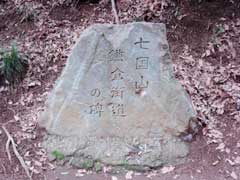
Satsuki and Mei's house
This is a hybrid Japanese-Western house (the Japanese part is the back, including the kitchen and bath, and the Western part is the two storey addition with a sunroom and a porch). Such houses were once very common in Japan. The artist 男鹿和雄 (OGA Kazuo) based the house in the story on a similar looking house of a relative.
Here is the floor plan of the house:
The 2005 World Exposition in Aichi recreated this house as an attraction for visitors. For more information, see this link.
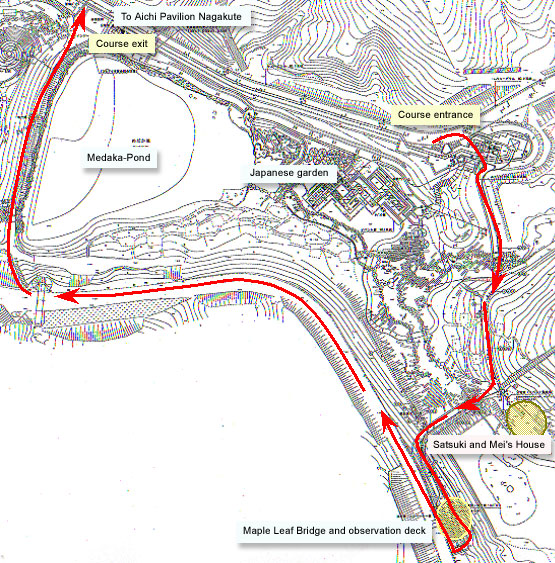
It is possible to buy a book that details the architectural plans and pictures of the construction of this house: サツキとメイの家のつくり方 (How to Build Satsuki and Mei's House):
Here is a sample of the architecture plans (House Front Layout):
For those that are truly obsessed (such as me!) 宮崎さま has written a book called トトロの住む家 (Houses where Totoro Live) showing real houses that inspired the house used in the film:
When did the story take place?
According to the map of the village, the story takes place around 30 years into the Shouwa (昭和) reign. Since this period commenced in 1926, this means the story is set around 1956.
Incidentally, the storyboard states that the beginning of the film takes place in May, although this is not immediately obvious in the opening scenes. However, the astute viewer can deduce the month through a number of ways:
- メイ sounds the same as "May", which is of course the English word for the fifth month in the calendar year. サツキ sounds like the old Japanese word for the month of May. Both girls are therefore named after the month of May.
- A calendar depicting the month of May is visible in the father's study.
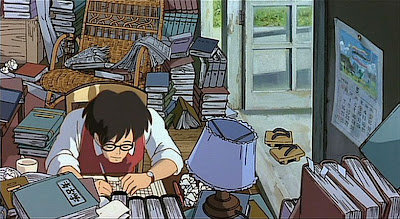
- When the father and two girls visit their mother in hospital, the calendar in the hospital ward says 「6月」 (June).

- In the classroom scene, the date on the blackboard can be seen to be 「6月23日」 (the 23rd of June).
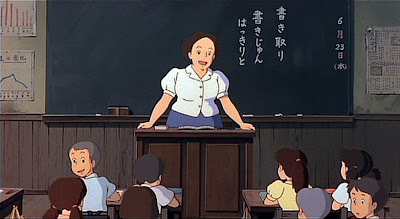
- Furthermore, after class, there is torrential rain, which is typical of the つゆ (rainy season) which hits Tokyo every year in June (resulting in a month of almost continuous rain). Therefore, the family would probably have moved in May, to avoid the rainy season.
At various times, the film depict the passage of time. When the mother reads サツキ's letter, the calendar in the hospital ward wall has advanced to July.
At the end of the film, the calendar shows August in the scene where the mother is talking to the father (being watched by the two girls in the tree).
Therefore, we can safely assume that the events in the film take place over May-August of 1956.
The film in relation to the "hero myth"
宮崎さま has often been called the "Walt Disney of Japan" and it is certainly tempting to think of Studio Ghibli films as Japan's version of Disney animations. Is this really true?
Many Disney films (and indeed, many other popular films such as the Star Wars series) tend to follow a "monomyth" storyline based on research on comparative mythology by Joseph Campbell (and summarised in his book The Hero With a Thousand Faces). A former Disney executive, Christopher Vogler, summarises Campbell's monomyth theories in an infamous memo entitled "A Practical Guide to The Hero with a Thousand Faces." In this memo, Vogler argues that Campbell was essentially saying that stories based on a condensed version of the monomyth (the "hero myth") are modelled on the workings of the human mind or psyche, and therefore have universal appeal.
The "hero myth" can be summarised thus: The hero is introduced in his ordinary world, where he receives the call to adventure. He is reluctant at first but is encouraged by the wise old man or woman to cross the first threshold, where he encounters tests and helpers. He reaches the innermost cave, where he endures the supreme ordeal. He seizes the sword or the treasure and is pursued on the road back to his world. He is resurrected and transformed by his experience. He returns to his ordinary world with a treasure, boon, or elixir to benefit his world.
Does となりのトトロ conform to the hero myth? Who is the hero? Is it サツキ? Or is it メイ? Or both of them? We know from early sketches, originally the story was intended to feature a single girl, who was later split into two sisters. Accordingly, we can analyse the mapping of the film's storyline into the hero myth from the perspectives of both サツキ and メイ:
STAGES OF THE HERO MYTH |
サツキ |
メイ |
| 1) THE HERO IS INTRODUCED IN HIS ORDINARY WORLD. | Both girls are depicted, at least initially as "typical" sisters sitting in the back of a truck travelling in the countryside. | |
| 2) THE CALL TO ADVENTURE. | The "adventure", at least initially, is the family moving from the city to a small village. | |
| 3) THE HERO IS RELUCTANT AT FIRST. | The girls encounter things they have never seen before. There are hint of "supernatural" elements in the plot. | |
| 4) THE HERO IS ENCOURAGED BY THE WISE OLD MAN OR WOMAN. | Both the father and the ばあちゃん play the role of the wise old man and woman at various points in the story. In メイ's case, her older sister サツキ also sometimes play this role. | |
| 5) THE HERO PASSES THE FIRST THRESHOLD. | サツキ encounters トトロ at the bus stop. | メイ encounters トトロ in the forest, sleeping underneath the camphor tree. |
| 6) THE HERO ENCOUNTERS TESTS AND HELPERS. | サツキ's initial test is whether she believes メイ's meeting with トトロ. カンタ turns out to be an important ally to サツキ, even though they both initially show a dislike for each other (mingled with fascination). The girls' midnight adventure with the seeds sprouting and their ride with トトロ are a shared test for both サツキ and メイ. | Tests include being brave enough to capture a ススワタリ at the beginning of the film, and encountering a goat in the middle of the film. メイ's key helper is サツキ. |
| 7) THE HERO REACHES THE INNERMOST CAVE | For both girls, this is when the telegram from the hospital arrives, which bring out their shared secret fear that their mother may die. | |
| 8) THE HERO ENDURES THE SUPREME ORDEAL. | サツキ's quest is finding her lost sister before nightfall. | メイ's quest is essentially the delivery of an ear of corn to her mother in hospital. |
| 9) THE HERO SIEZES THE SWORD. | サツキ's "sword" is none other than トトロ, whom she seeks out as an act of final desperation. | メイ's "sword" is the ear of corn, which she believes will help heal her mother. |
| 10) THE ROAD BACK. | トトロ summons the ネコバス who carry サツキ to メイ. | ネコバス also delivers サツキ and メイ to the hospital. |
| 11) RESURRECTION. | The girls are glad to see that their mother is apparently healthy and talking to their father. メイ successfully delivers the corn. | |
| 12) RETURN WITH THE ELIXIR. | Mother returns from hospital, and the girls are showing leading "normal" lives. They will never forget トトロ but probably will never meet him again. He has been replaced by human friends. | |
Despite the above mapping, I am not entirely convinced となりのトトロ is a canonical "hero myth." In typical hero myths, the hero's quest is essentially selfish, and success in the quest will reward the hero either directly or indirectly. For both girls, their quests were essentially for altruistic reasons (although it could be argued success does directly benefit them).
Also, in the hero myth, the hero always has a choice whether to undertake the quest or not. In this film, both girls essentially believe there is "no choice" but to embark on their respectives quests. メイ believes that her mother will die unless she delivers the corn, and for サツキ, finding メイ before nightfall is mandatory.
I believe the modifications to the hero myth (the framing of the altruistic motives for the quests, as well as a perception of lack of choice) help "Japanize" the myth to Japanese audiences, and appeal to quintessentially Japanese values. Does this potentially lessen the impact of the film to non-Japanese audiences? Perhaps. I have one friend (adult) who finds the film "weird" (although his two young girls loved it) and it is arguable that the film does not have as much of an impact on young non-Japanese children as it seems to have on Japanese children.
The beginning of the film
After the animated opening credits (featuring メイ walking amongst animals and insects), the film opens on a landscape of a rural countryside with cornfields. A quaint three-wheeled truck laden with furniture comes into view.
Inside the truck are two girls sharing a pack of caramel lollies surrounded by books. Judging by some of the titles of the books in the back of the car, the father is either a scholar or academic: 鉱物 (Minerals), 古代史 (Ancient history), 世界文 (World culture), ...
The older girl, サツキ, offers some gum to her father sitting in the front passenger seat. Suddenly she spots a man riding on a bicycle. Thinking the man to be a policeman (周りさん), サツキ asks her sister メイ to hide. I have been wondering exactly why two girls would want to hide from a policeman. Perhaps the girls may have recently been involved in some sort of mischief, just like Emil in Erich Kästner's Emil und die Detektive was reluctant to approach a policeman when his wallet was stolen. Or perhaps the girls are not meant to be travelling in the back of a truck and have been instructed by their father to keep out of sight from policemen.
The three-wheeled truck passes a small bus, and turns into a gravel road which passes a small and mysterious Inari (fox god) shrine.
The truck passes through more paddy fields and stops at a house where a boy is scooping hay on the ground, and the father asks the boy (in honorific Japanese): 「お家の方 どなたか いらっしゃいませんか。」 ("Isn't someone from the house around?")
The boy points to the fields, the father thanks him and then shouts to two small figures toiling away in the fields: 「草壁です。引っ越してきましたぁ!よろしくお願いしまーす。」 ("This is Kusakabe. We're moving house to here! Nice to meet you! [actually, literally it's 'Please be nice to us!']")
We see the two human figures bowing deeply. The truck then moves on and heads towards a small forest dominated by a huge camphor tree.
Even though the scene may be reasonably straightforward, the astute viewer will have already noticed several things that perhaps someone unfamiliar with Japanese culture may not. The design of the truck and bus indicates the story is taking part in the late 1950s (indeed, a similar looking three-wheeled truck is on display in the Motor Museum at the Venus Fort in Odaiba, Tokyo). We have a family moving house. The girls chewing caramel lollies indicate that they have come from a big city (and therefore being in the countryside is probably a new experience from them). The presence of a bus route indicates that this place is not too far from the city. The presence of the Inari shrine indicates that there is a supernatural dimension to the story.
Finally, the truck's relatively small size indicates that the family does not have much furniture, and therefore not wealthy. However, the father is clearly well-educated and well-mannered, judging from the way he addresses the boy and his parents using a combination of polite and honorific language (in perfect standard Tokyo dialect). Together with the presence of books inside the truck, the father's occupation as a university academic (but probably not a professor) can be easily deduced. Moreover, the father's educated background, combined with the lack of furniture, suggest that the family may have seen better times, but perhaps have lost their wealth and belongings in World War II during the fire-bombing of Tokyo.
At the house
When the truck arrives at the house, our suspicion that the family is used to living in the city is confirmed. The girls are excited about little things like a bridge, fish in the stream, and a tunnel formed by trees. As the girls run towards the house, the viewer sees a large house:
As the girls approach the house, they realise it is very old and remark that it looks like a haunted house (お化けやしき). This is another clue that the film deals with supernatural themes. They realise the porch is very old and may collapse. They play excitedly in the front of the house, until they see the amazing huge tree. Father tells them that it is a camphor tree (クスの木). They also find acorns (ドングリ) in the house, and speculates whether these have been left behind by squirrels (or perhaps mice).
The father asks them to open the storm shutters (雨戸) using a rather interesting sentence involving a double negative: 「雨戸が開けられないじゃないか」
As the girls open the kitchen and bathroom, they discover the presence of many small tiny black creatures that scurry away in the presence of light.
This is the first confirmation of the supernatural element of the story. They ask their father, who suggests that it may be the マックロクロスケ from their picture book. He also suggests a scientific explanation: that the black spots are caused by their eyes adjusting to the sudden switch from bright to darkness (another hint that the father is an academic). The girls accept this explanation and make a joke about forcing the マックロクロスケ to come out otherwise they will poke their eyeballs.
The father then asks the girls to find the stairs to the upper floor. When they do find the stairs, サツキ remarks that it is pitch black: 「まっくらだね」 and this immediately causes メイ to repeat the word マックロクロスケ (in a hushed voice) and suddenly an acorn drops down the stairs accompanied by rustling noises. The girls are now not so convinced of the scientific explanation. After climbing the stairs, サツキ asks somewhat timidly 「マックロクロスケさん、いませんか?」 (literally "Mr. Makkurokurosuke, are you not here?"), and then rushes to open the window, but by the time she has done so, the マックロクロスケ have disappeared into a hole. Nevertheless, she yells out to father that there is definitely something strange here, and the father jokingly replies he has always wanted to live in a haunted house ever since he was a child.
As サツキ goes downstairs to help her father, メイ is determined to see the マックロクロスケ. She pokes her finger into the hole, and out they come! She manages to trap a stray one.
Mei rushes downstairs to show her sister, only to be frightened by Kanta's grandmother, who is helping to clean the house. サツキ introduces herself and メイ to the grandmother, and notices how dirty メイ's hands and feet are. As the girls tell the grandmother about the マックロクロスケ, the grandmother refers to them as ススワタリ and says she too saw them when she was a child, but adults cannot see them.
The film then briefly shows an imaginary scene (the girls imagine the ススワタリ clustering in the attic, surrounding the good luck charm that is attached to the house):
Later on, we see the family unpacking with the help of おばあちゃん and the removalist. カンタ delivers a basket containing rice cakes from his mother and yells out to サツキ that their house is haunted. サツキ is incensed by this comment and announces she hates boys, but loves ばあちゃん's rice cakes.
Later on in the evening, a strong wind blows (signalling the start of the つゆ season) whilst the family takes a bath.
メイ is worried that the house may collapse because it is so old, but the father says laughter will drive away the fears. メイ is adamant that she is not afraid but soon joins in when tickled by サツキ. The family's laughter drives away the last remaining ススワタリ into the forest.
I find the bathroom scene touching because it humanizes the father (who up till now has been friendly, but given the stereotype that Japanese fathers are not close to their children due to long work hours, we don't really know what sort of relationship he has with the girls). The scene is also touching because it acutely highlights the absence of the mother, typically the unifying figure in any Japanese family. The astute viewer by now will be wondering "What happened to the mother? Is she dead?" If the parents are divorced, it would be almost unthinkable that the father will move to the countryside with the kids unless the mother is physically incapable of looking after the children.
Visiting the hospital
In the next scene, the viewer receives an answer to the puzzle of the missing mother. It turns out she is in hospital, and the family is visiting her today.
The calendar on the wall of the hospital ward shows that this scene takes place in June, about a month after the family has settled in. Another hint of the passage of time is that the mother does not ask the girls about the relocation, indicating that it was sometime in the past. From this we can deduce that these hospital visits happen quite often.
メイ remarks to her mother that the family managed to get lost on the way to the hospital. Given that this is not their first visit, this is a hint that the route to the hospital is quite complex with many turn-offs (an important clue to the events in the latter part of the movie).
メイ's discovery of トトロ
It is morning. The father wakes up late again, and サツキ announces that from now on she will cook breakfast as well as prepare the lunch (今日から私 お弁当よ).
She does a reasonable job, even if メイ points out the fish is burnt. Whilst the family is eating breakfast, サツキ's friend みつ子 (nicknamed みっちゃん) arrives at the front of the house. メイ is intrigued that サツキ is referred by her friend as サツキちゃん. サツキ hurriedly finishes breakfast and rushes to school with her friend.
After breakfast, father settles down to do some research at home, and メイ potters around in the garden. Whilst playing with an old bucket with a hole at the bottom, she spies an acorn and soon begins to collect acorns scattered around the path. Suddenly, she spots 小トトロ (small Totoro) going down the path. The 小トトロ appears to fade in and out of view, but as she chases it, it solidifies and runs underneath the house. メイ soon spots a medium sized blue 中トトロ. She chases both creatures into the forest.
メイ eventually stumbles into a hole at the base of the giant camphor true.
Here メイ encounters a giant sleeping トトロ.
メイ manages to get on top of トトロ.
メイ starts tickling トトロ. In response, it lets out a series of roars that メイ interprets as the creature's name. メイ also roars in return, much to the creature's surprise.
After that, the creatures settles down, and so does メイ, in a peaceful scene where they both doze off together.
When サツキ returns home from school, she and her father search for the missing メイ. They eventually find her sleeping in the path underneath the forest. メイ said she saw トトロ but can't find to find him anywhere, and the hole into the middle of the tree has disappeared. The father suggests that トトロ may be the "keeper" of the forest and they offer a brief prayer at the shrine before racing back home.
In the Classroom
One day whilst サツキ is studying in class, メイ appears with ばあちゃん. Apparently father is at the university today and メイ is at ばあちゃん's house. However, she became bored and lonely and started crying and demanded to see サツキ, so ばあちゃん had to take her to school. サツキ managed to receive permission from the teacher for メイ to join her in class.
The children appear to be studying Japanese (the textbook the girls are holding says 国語 or "National Language"). メイ starts drawing a picture of トトロ, which arouses curiosity amongst サツキ's classmates.
On the blackboard, the date 6月23日 (the 23rd of June) can be seen on the right hand side. Also on the blackboard, the teacher wrote 「書き取り 書きじゅん はっきりと」 (Transcribe the stroke order clearly). Clearly, the students are in the middle of a 漢字 writing drill.
カンタ is caught by the teacher taking a sneak peek at サツキ and resumes his writing drills. However, there is something strange about the characters that カンタ is transcribing:
カンタ is in the middle of writing 「松」. This is the character for the word まつ (pine nut). It is a character normally learnt in Grade 4, which is consistent with サツキ being a fourth grader. However, the word to it's right is 「河」 which is a Grade 5 character meaning かわ (river). On the extreme right, the character is 「持」 which is used in the word 持つ(まつ) meaning "wait." This is a Grade 3 character.
So, is this a Grade 3, 4 or 5 class? Furthermore, my understanding is that 漢字 classroom writing practice stops after Grade 3.
Perhaps this is an attempt to ensure grade schoolchild viewers (of multiple ages) identify with the drill practice. Or perhaps 宮崎さま's recollection of his early schooldays is a bit hazy!
At the bus stop
After class, サツキ waves goodbye to her friends and walks home with メイ. She remarks to メイ that they need to hurry because it may rain, and sure enough the rain starts pouring down. They start running because neither of them has an umbrella, but メイ falls down into a puddle. They stop by at a small 地蔵 (Jizou, protector of children and travellers) shrine by the road.
As they pray to 地蔵さま, カンタ walks by. At first, he is determined to ignore them, but soon changes his mind and offers his old and battered umbrella to them. サツキ hesitates, but カンタ forces the issue by dropping his umbrella and running away. As he runs away, we see an exultant look on his face and he leaps with joy.
The girls walk home with the umbrella. During dinner, サツキ realises father has forgotten his umbrella so they decide to meet him at the bus stop. On the way, they stop by and return カンタ's umbrella, much to the delight of his mother who had been berating カンタ for "losing" his umbrella during the rain. カンタ hides when he sees the girls coming, but when his grandmother asks "Who came?" he pretends he doesn't know (but we see the joy on this face).
At the bus stop, which is called 稲荷前 (Inarimae, or literally "in front of the Inari shrine"), they wait for the bus. Incidentally, the characters on the sign at the bus stop says (from top to bottom):
- 七国山行 (Shichikokuyama bus route)
- 稲荷前 (Inarimae)
- 東電銑バス (Azuma Dentetsu Bus)
When the bus arrives (the sign on the top front says 七国山 which indicates the bus is on the way to the hospital), the girls are disappointed when the father is not on it.
メイ soons become bored of waiting at startings playing the puddle. She wanders over to the Inari shrine, but is spooked out by the statues which look scary at night.
メイ soon becomes sleepy and サツキ is forced to carry her on her back. Soon, however, they are joined by none other than トトロ…
Stunned, サツキ offers トトロ her father's umbrella. At first he doesn't know how to use it, but サツキ shows him. He makes a huge stomp which causes all the droplets on the tree to come down to test the umbrella's effectiveness, and is joyful to learn that the umbrella is much better than the leaf he had been using previously. Soon a bus can be seen to be coming, but wait, it does not appear to be the normal bus ...
Totoro boards the ネコバス, much to the girls' amazement. But before he leaves, he offers them a small present in return for the umbrella. Soon after that, the normal bus appears, with father on it.
The girls excitedly tell father about トトロ, and at home サツキ writes about the experience in a letter to her mother.
サツキ's letters to her mother
We know that サツキ corresponded regularly with her mother, because her mother was writing a letter when they visited her, and one of the letters that were read in the film was titled "No. 5." However, in the film, we only get to see excepts from two letters, one sent after メイ discovered トトロ and the other sent after メイ and サツキ met トトロ at the bus stop.
The first letter reads (in part):
お母さん、お元気ですか。今日は とってもすごいニュースがあるんです。メイが お化けのトトロに 出会いました。
Mother, are you well? Today, I have really terrific news. メイ met トトロ...
The rest of the letter can't be read, but there are interesting fragments such as 「とても大きくて ヒゲが…」 (very big whiskers ...).
The voiceover then continues 「自分も会えたらいいなと思っています」 (I am thinking it would be nice for me to meet トトロ too ...)
The second letter is a longer excerpt:
(トトロのくれたお礼もステキ)だったの。ササの葉でくるんで竜のヒゲでしばってあるつつみでした。家にかえってから、みんなであけました。そしたら中からきれいな木の実がいっぱい出てきました。おとうさんは
(The present that Totoro gave was great). It was a package bound in sasa leaves and tied with a dragon's whisker. After we returned home, we opened it. From the inside, lots beautiful nuts came out. About father, ...
木の実がたくさん入っていました。いろんな種類のドングリで、とてもきれいです。ちょっともっといないけどお家の庭が森になったらすてきなので木の実は庭にまくことにしました。でもなかなか芽が出ません。メイは毎日毎日まだ出ないまだ出ないと言います。まるで猿カニがっせんのカニになったみたい。
... entered lots of nuts. The various types of acorns are very beautiful.Wouldn't it be great if our house garden became a forest? Because of that, we scattered the nuts around the garden. But none of them have sprouted. Every day メイ says "Still not out! Still not out!" メイ circles the garden looking like the crab in the fairytale of さるかに合戦 (the Monkey-Crab Battle).
メイガに (picture of a crab that looks like メイ):
The Path of the Wind
One night, as the girls prepare to go to bed, メイ asks whether the leaves will sprout tomorrow, and the father replies perhaps トトロ knows ...
The girls awake in the middle of the night by the sound of the wind. To their amazement, they see トトロ performing a strange ritual in their garden at the spot where they planted the seeds. They excitedly join トトロ. He seems to be concentrating furiously, and soon enough the leaves begin sprouting. The plants grew at an amazing rate and soon becomes a forest. トトロ then jumps onto a spinning top, and invites the girls to join him in following the path of the wind.
In the meantime, the father is studying, oblivious to the girls' adventure.
He imagines he hears something, and it is the sound of the girls joining トトロ in blowing on オカリナ.
The telegram
One day, the girls help ばあちゃん pick some corn and vegetables for lunch.
As they eat lunch, ばあちゃん tells them that eating her vegetables will make them healthy. メイ is excited by this information and wonders if her mother will get well if she eats the corn that メイ has picked. When ばあちゃん replies affirmatively, メイ decides she will give the corn to mother when she sees her next.
In the meantime, the telegram delivery boy tries to deliver a telegram, but can't find anyone at home. He delivers it to カンタ's house instead, and カンタ takes it to them. サツキ is frightened when she learns it is from the hospital:
The telegram has a simple message, which is "Please contact the hospital" but サツキ fears the worst: that something terrible has happened to mother. サツキ and カンタ rush to カンタ's uncle's house in the village, where there is a telephone [It is common for small villages to only have one telephone installed in one house, but the telephone is meant to be shared by the villagers. When I was growing up, I remembered my grandmother living in a similar village with one phone.] サツキ calls her father.
In the meantime, メイ has been trying to follow サツキ and カンタ (despite being told to stay with ばあちゃん). She gets lost in the village, and encounters a goat that is very interested in the corn she is carrying. She fends off the goat, and says the corn is for mother:
Father tells サツキ on the telephone not to worry, but mother has caught a cold and he will visit mother in the evening to check up on her. When サツキ relays this to メイ, メイ becomes upset and refuses to believe the story (possibly fearing that サツキ is hiding bad news from her). The girls have a loud argument, and then refuse to speak to each other.
Later on in the afternoon, after the girls have had an afternoon nap, サツキ confides to ばあちゃん that she secretly shares メイ's fear that perhaps the situation is far worse than what has been communicated over the telephone. サツキ says when mother entered hospital, the explanation was also that she has caught a "cold" and サツキ wonders what will become of the family if mother dies. She starts crying.
Unknown to サツキ and ばあちゃん, メイ has overheard their conversation, which confirms her earlier suspicion that something serious has happened.
A lost child
Determined to prevent her mother from dying, メイ decides to take the corn to the hospital by walking there (a journey that normally takes an adult around 3 hours!).
When サツキ discovers that メイ is missing, a frantic search is organised to find the lost child before sundown. サツキ runs towards the hospital, but everyone she encounters, including a cute young couple (who has just returned from the hospital), has not seen her:
カンタ catches up with サツキ and informs her that someone has found a child's slipper in the pond. Fearing the worst, サツキ rushes back to the village whilst カンタ continues the search.
Fortunately, the slipper turned out not to be メイ's:
As the sun sets, サツキ decides to try her one last remaining hope. She goes to the giant camphor tree to look for トトロ, and manages to find him sleeping. She explains the situation, and he gives her a grin and takes her to the top of the tree where he starts yelling:
Much to サツキ's surprise, the ネコバス responds to トトロ's call:
As サツキ boards the bus. the destination sign on top goes through a number of changes:
- 塚森 (Tsukamori)
- 永沢 (Nagasawa)
- 三っ塚 (Mitsuzuka)
- 墓道 (Bodou)
- 大社 (Taisha - Grand Shrine)
- 牛沼 (Ushinuma)
But finally, the destination reads 「めい」 (Mei, written in ひらがな) and we know that it will take サツキ to メイ:
In the meantime, メイ is totally exhausted and resting in front of a row of 地蔵 (Jizou) statues. Because 地蔵 is the protector of children, this is a good sign that メイ is unharmed:
The ネコバス rushes through the paddy fields (invisible to the villagers searching for メイ) and finally arrives where メイ is. The two sisters joyfully hug each other. The ネコバス, anticipating their thoughts, changes the destination sign to 七国山病院 (Shichikokuyama Hospital, but the last character is written partially mirrored and partially upside down - I guess the ネコバス is a bit over-excited!):
The ネコバス delivers the children safely to the hospital, and they are glad to see father chatting to an apparently healthy mother:
The girls view the conversation from the vantage point of sitting on a tree branch:
Mother remarks that for a moment, it seems she can see サツキ and メイ staring at her from the tree:
Father find something left at the window, and exclaims that mother may well be right, for the children has left behind a gift (the ひらがな says おかあさんへ or "To Mother"):
The end of the film
The ネコバス takes the children back to the village, where they are warmly greeted by ばあちゃん and the rest of the villagers. The film concludes with the ending titles, and we see the mother eventually recovering and returning back to the family:
We also see a happy scene where the mother is finally able to take a bath with the girls:
During bedtime, she reads the fable of 三匹の山羊 (The Three Billy Goats Gruff, translated from the Norwegian De tre bukkene Bruse) to the girls (this is the book where メイ first saw a picture of トトロ):
Copyright © Chris Tham, 2008









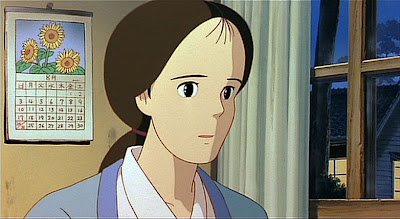

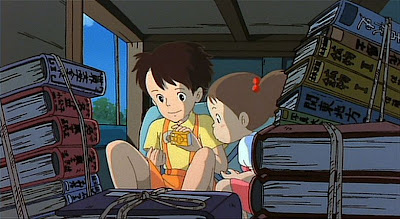

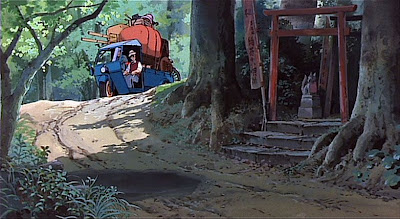

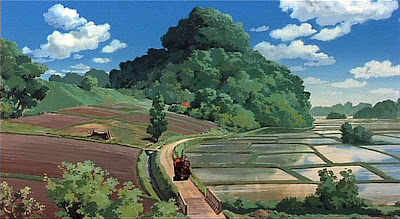

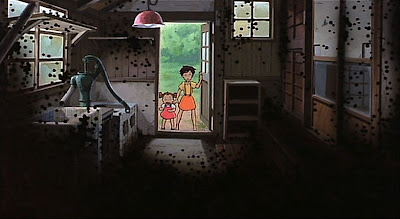
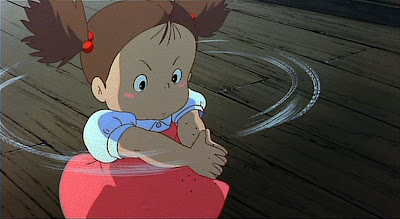


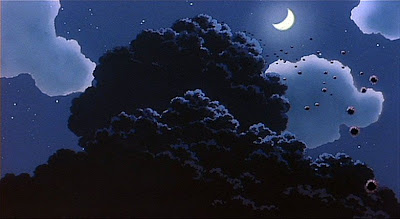
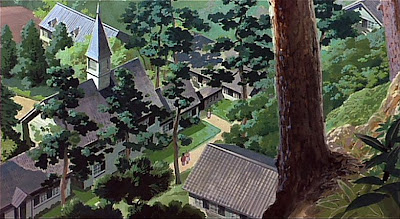
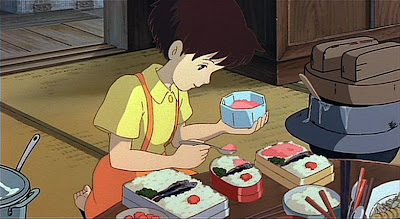

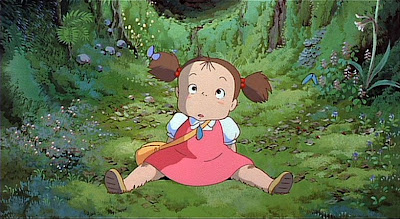
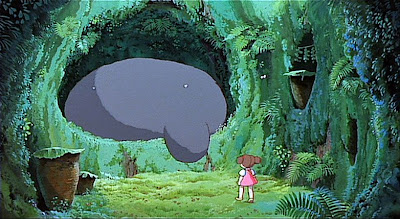
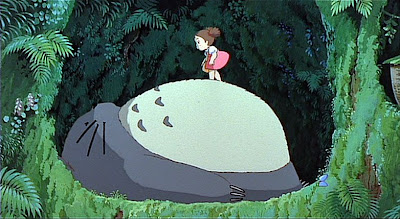
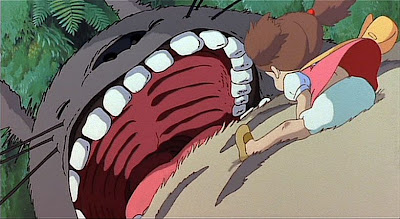



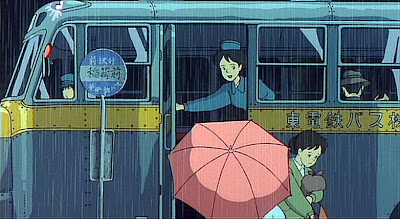
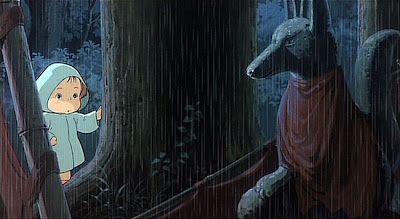
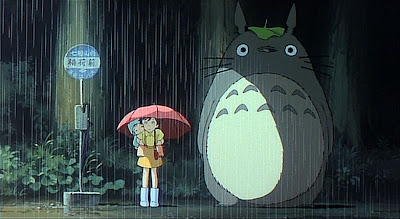
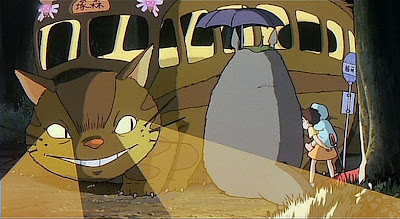
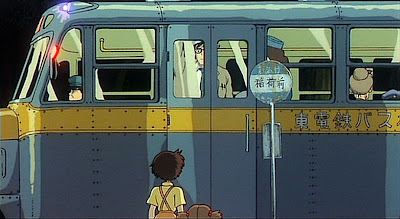
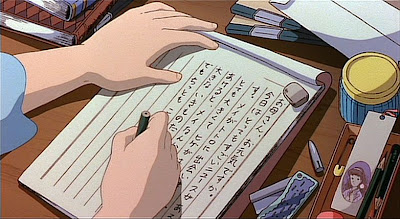
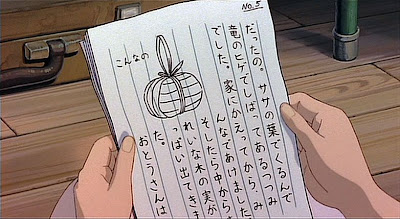
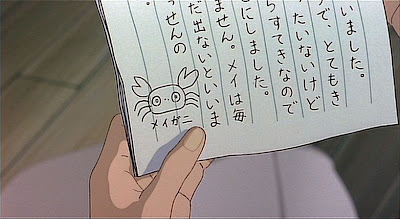
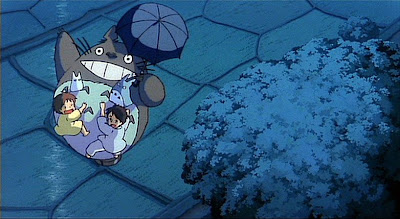
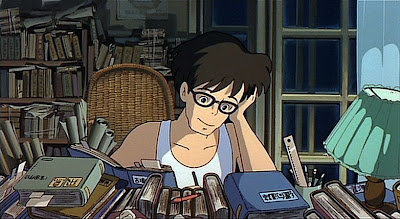
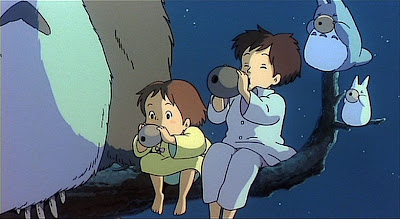
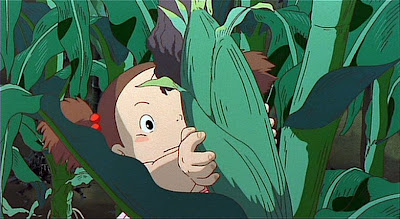
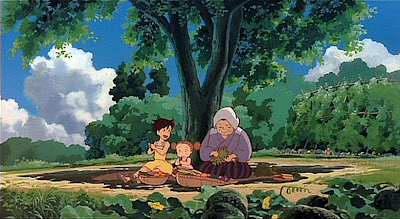
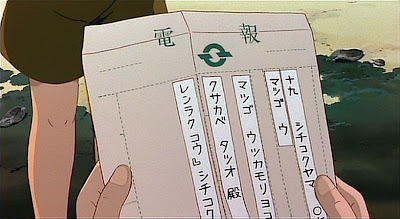


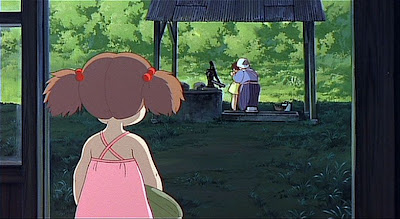
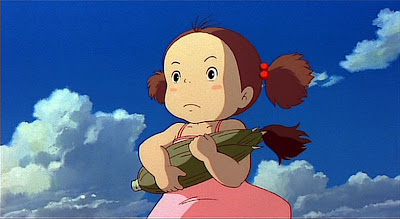

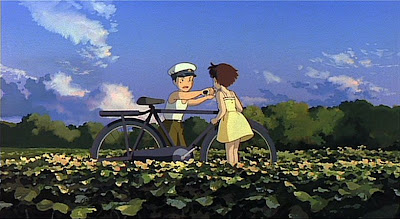
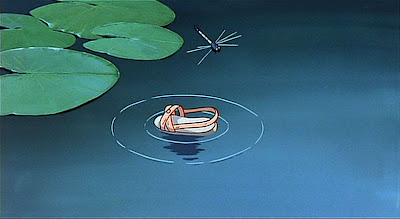
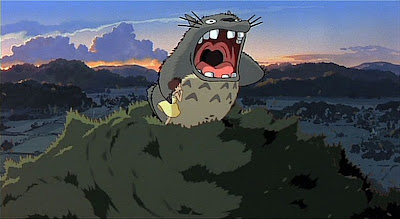

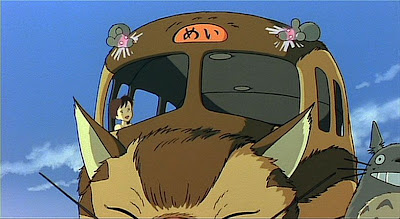
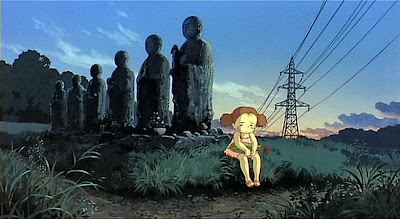
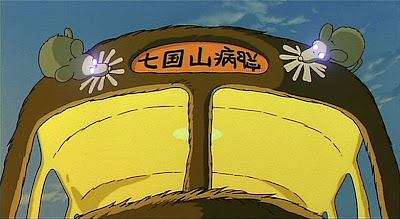


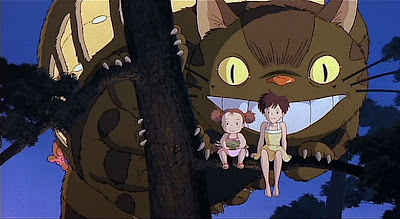
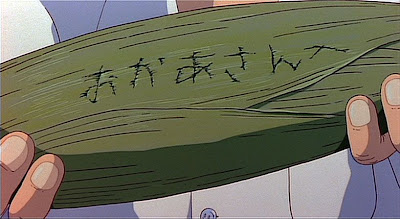
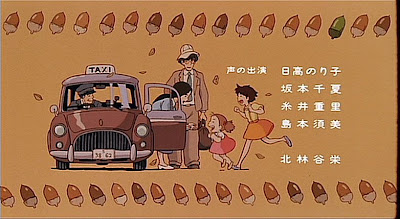
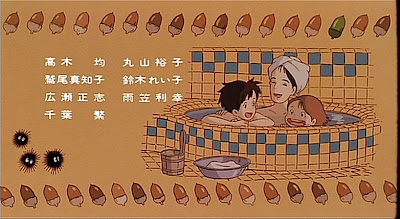

10 comments:
What an awesome article. I was just checking the beggining when I see myself reaching the end.
BTW, you confused matsu (wait) with motsu (hold) kanjis in the writing drills.
This is an amazing article. Thank you.
Wow... brilliant article
I can just see the amount of work
you put into it.
I love Miyazaki and his work! its
great to see that such an article
was written.
Nice article! I believe though that your interpretation of how Mei perceives totoro's name is slightly mistaken. I don't believe Mei said "ちゃんっと言ったもん", but rather, "ちゃんといたもん", "He really was there!". As to whether Satsuki's assessment of it being "you mean the troll from the picture book" is correct or not doesn't seem that important. However, we see signs of Mei's language confusion in a couple of other places, so the mistake of トトロ instead of トロル does seem plausible. She calls polliwogs "おじゃまたくし" instead of "おたまじゃくし", and "トウモロコシ" she calls "とうもころし".
Awesome movie. Thanks for the article!
hello, I ran across your amazing Totoro notes while searching the web to find out where this movie was supposed to take place. I wanted to visit there ^__^ とてもざんねんです・・・oh well! I shall stop being melancholy because there's still many beautiful countrysides in Japan. they may not be Totoro's forest, but ..... -sniffle- it's my natsukashii memory too. thank you so much for all your research and sharing it with us! どうもありがとう♪
Seriously, this is the most detailed analysis of Totoro I've ever seen! Many thanks!
A lovely piece of writing.
That was such a great article highlighting so many wonderful things I would otherwise have missed. Thank you!
Post a Comment